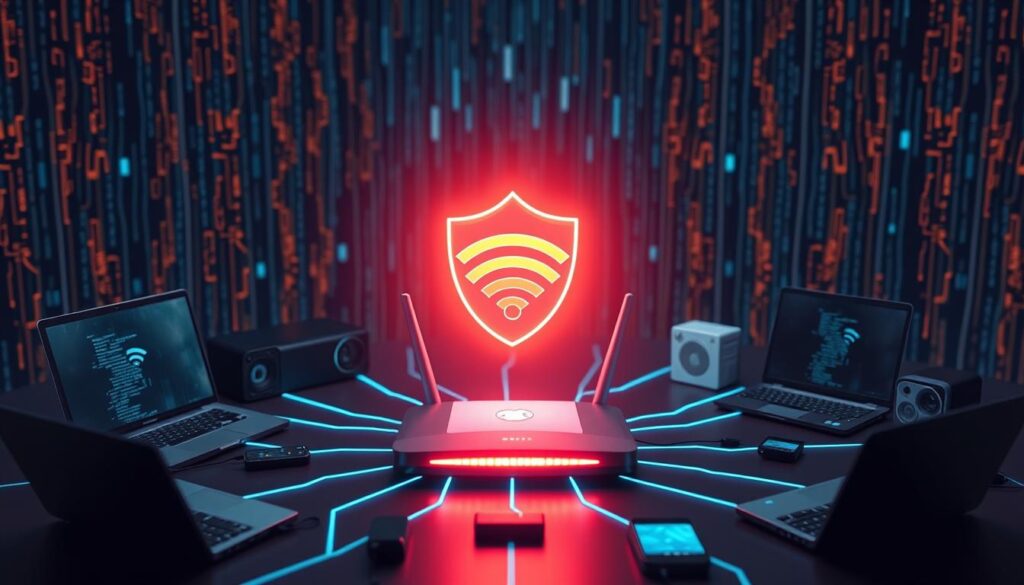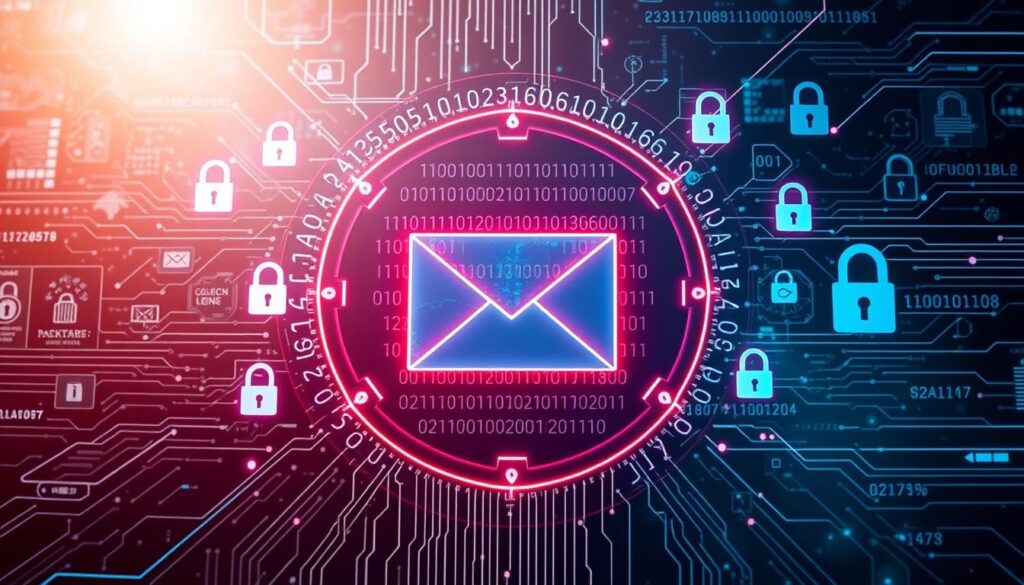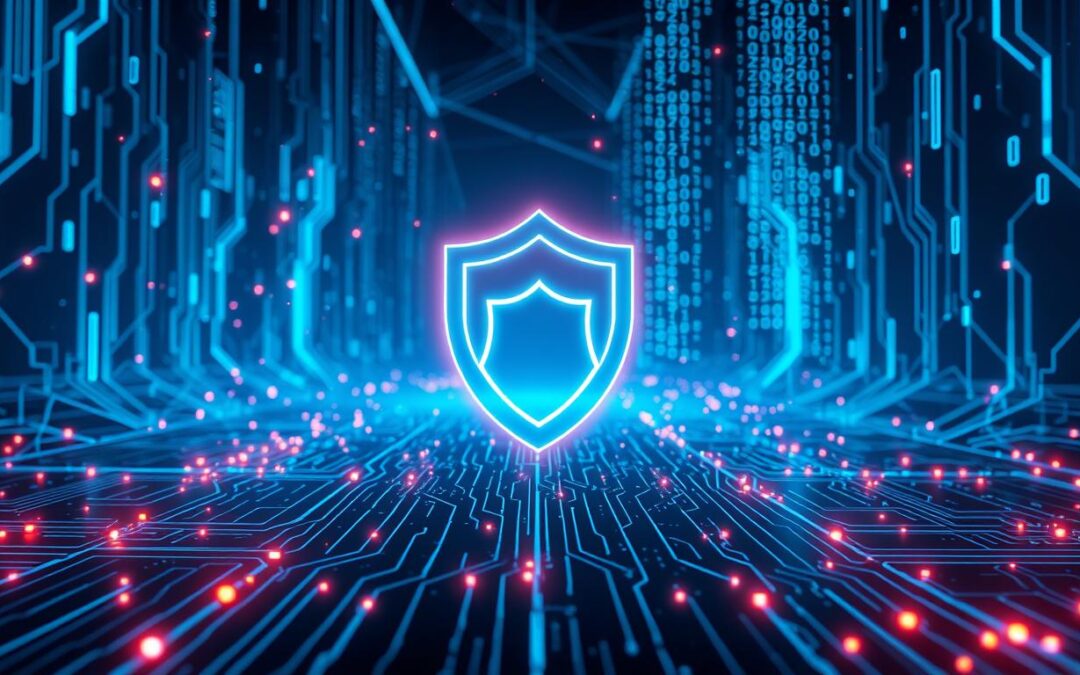Cybersecurity is key in our digital world. It’s important to take simple steps to stay safe online. With more cyber threats, knowing how to protect ourselves is crucial.
Cyber scams are on the rise. Con artists target online users every day. This makes keeping our information safe a top priority.
Many people think they’re not at risk. But cyber criminals target almost anyone. Using multifactor authentication instead of passwords is recommended. This can help keep your data safe.
Experts say making your own password is less safe than using a random one. A culture of cybersecurity awareness is vital. Sharing knowledge can cut cyber risk by 75%.
By focusing on cybersecurity, you can protect your digital life. This helps prevent threats to your network and information security.
Key Takeaways
- Implementing multifactor authentication can significantly reduce the risk of unauthorized access
- Using strong, unique passwords for each account can enhance security
- Regularly updating anti-virus software is essential for defending against the latest threats
- Reporting suspicious emails or links can help prevent wider security breaches within an organization
- Prioritizing cybersecurity awareness can reduce the risk of cyber incidents by around 75%
Understanding the Basics of Cybersecurity
Cybersecurity is key to our digital safety. It’s vital to know the basics to shield ourselves from cyber threats. With more online activities, the danger of cyber attacks has grown. Recently, we’ve seen more complex cyber scams, showing the need for strong cyber defenses and IT security.
To keep safe online, we must know the common cyber threats and how to defend against them. This means using strong passwords, updating our software, and being careful with links and attachments from unknown sources. By learning about cybersecurity and taking action, we can lower the risk of cyber attacks and safeguard our digital world.
The core of cybersecurity is about keeping information safe, secure, and accessible. By following these guidelines and staying updated on cyber threats and cyber defenses, we can protect our online safety and digital lives.
Creating Strong Passwords That Actually Work
Effective password management is key in today’s digital world. With over 160 online accounts on average, having a plan for strong passwords is vital. It’s important to use a different password for each account to avoid big security risks.
Using a password manager boosts password security by creating and storing complex passwords. People with password managers are 30% more likely to use strong, unique passwords. Also, accounts with multi-factor authentication (MFA) are 99.9% safer from hackers.
- Use a mix of uppercase letters, lowercase letters, numbers, and symbols.
- Make passwords at least 12 characters long, but aim for 14 or more.
- Stay away from easy-to-guess info like birthdays or common words.
By following these guidelines and using a password manager, you can greatly enhance your password security. This will help protect you from cyber threats.
Two-Factor Authentication: Your Digital Security Guard
Two-factor authentication (2FA) adds a strong layer of protection against unauthorized access. It requires two different ways to prove who you are. This makes it much harder for hackers to get into your accounts.
About 80% of data breaches happen because of weak passwords. Using 2FA can cut down the risk of account breaches by almost 100%. It’s a powerful tool for keeping your digital world safe.
- Reduced risk of unauthorized access
- Increased security against phishing attacks
- Improved protection of digital information
Adding 2FA to your digital security plan makes a big difference. It helps keep you safe online and gives you peace of mind.
Securing Your Home Network
Securing your home network is key in today’s digital world. It keeps your devices and personal data safe from cyber threats. A solid network security system stops unauthorized access to your home network.
Use strong passwords, update software regularly, and enable a firewall. About 64% of homes have many internet-connected devices. This makes them a bigger target for cyber threats.
To safeguard your home network, use cybersecurity solutions like WPA2 encryption. Also, update your router firmware often. Only 20% of users do this, leaving most devices open to attacks. Here are some ways to secure your home network:
- Use a strong and unique password for your Wi-Fi network
- Keep your router firmware up to date
- Use a firewall to block unauthorized access
- Set up a guest network to reduce the risk of exposure

By following these tips and using cybersecurity solutions, you can keep your home network safe. Remember, keeping your home network secure is a continuous effort. It needs regular updates and care to protect your devices and data.
Essential Software Protection Tools
Keeping digital info safe from cyber threats is key today. With more complex threats, having the right tools is crucial. Antivirus software fights off threats like keyloggers and ransomware.
Firewall configuration stops unauthorized network access. Firewalls can be hardware, software, or both. VPNs encrypt data, making it hard for hackers to get to.
Top antivirus software includes scans and URL blocking. Norton AntiVirus Plus is known for its firewall protection. When picking antivirus, look at price, protection, and reviews.
Investing in these tools is vital for digital safety. Using antivirus software, firewall configuration, and VPNs lowers cyber threat risks. This protects sensitive data for everyone.
Safe Browsing Habits and Practices
Keeping your digital info safe is key. Always think before you click. This is because 91% of cyberattacks start with phishing emails.
To stay safe online, be careful with links and emails. Use strong passwords and keep your software updated. Updates can block up to 85% of cyber threats.
Two-factor authentication (2FA) is also a must. It can stop up to 99.9% of automated attacks if used right.
Here are some digital security tips:
- Use a password manager for strong, unique passwords
- Stay away from public Wi-Fi for sensitive tasks to avoid data theft
- Turn on 2FA for all accounts that support it
By following these tips, you can lower your risk of cyber threats. Remember, safe browsing is a continuous effort. Always stay alert to keep your online and digital security strong.
Protecting Your Mobile Devices
Mobile devices are now a big part of our lives. They need special care to stay safe from cyber threats. Mobile security is now a must, not just a nice-to-have.
Managing app permissions is key to keeping your smartphone secure. Be careful with the apps you install and the permissions you give them. Stick to trusted sources for apps and think twice about the permissions they ask for. App permission management is vital to stop bad apps from getting to your private info.
To boost mobile security, keep your device and apps current. Updates from Apple, Google, and Microsoft fix security holes. Also, use strong passwords, set your device to lock when idle, and turn it off often. These steps can greatly lower the chance of your device getting hacked.
Here are some top tips for keeping your mobile devices safe:
- Use encrypted apps for voice, text, and data
- Turn off Bluetooth when not using it
- Stay away from public Wi-Fi
- Only get apps from official stores
By following these tips and staying alert to mobile security, you can protect your device and personal info. Remember, keeping your mobile safe is an ongoing task that needs constant attention and effort.
Email Security and Phishing Prevention
Email security is key to staying safe online. Phishing attacks can cause big financial losses and harm personal data. In 2022, phishing was behind 52% of identity theft cases. To stay safe, be careful with links and emails, use strong passwords, and keep your software updated.
Getting regular phishing training helps a lot. Companies that train their teams well can cut phishing risks by up to 70%. Also, trained employees are 60% more likely to spot and report phishing. By doing these things, you can make your email safer and stop phishing attacks.

- Verify the authenticity of emails before responding or clicking on links
- Use multifactor authentication to add an extra layer of security
- Keep your operating system, browser, and email client up to date with the latest security patches
By following these tips and staying up to date on phishing tricks, you can lower your risk of getting attacked. This helps protect your digital world.
Social Media Privacy Settings and Best Practices
Keeping your social media private is key in today’s world. Cyber threats are on the rise, making it vital to protect your online life. Social media privacy settings and best practices can block unauthorized access to your info. Facebook’s two-factor authentication adds extra security to your account.
Instagram lets you control who sees your posts and personal info. Being careful with your privacy settings can lower cyber threat risks. Always check your privacy settings, especially after updates, to stay safe.
- Using strong, unique passwords for each account
- Enabling two-factor authentication whenever possible
- Limiting the amount of personal information shared online
- Regularly reviewing and updating your privacy settings
By following these tips and understanding social media privacy, you can safeguard against cyber threats. This way, you keep your online world safe and secure.
Data Backup Strategies for Personal Security
Having a strong data backup plan is key for personal security today. Cyber attacks and data breaches are common. So, it’s vital to have a good data backup system to avoid losing data and keep sensitive info safe.
A 3-2-1 backup strategy is widely used. It means having three copies of your data, on two different media types, and one offsite. This strategy helps in recovering data and lowers the chance of loss. Also, using cybersecurity solutions like encryption and secure cloud storage adds extra protection against unauthorized access.
There are many data backup choices, like external hard drives, cloud storage, and USB drives. Pick what works best for you and keeps your data safe. By focusing on data backup and personal security, you can greatly reduce data loss risks and safeguard your digital info from cyber threats.
With a solid data backup plan and cybersecurity solutions, you can keep your data safe from cyber threats and data breaches. Remember, personal security is as important as physical security. Protecting your digital info is essential in today’s digital world.
Responding to Security Breaches
Security breaches can be very costly. The average global cost of a data breach was $4.45 million in 2023, IBM’s report says. It’s important to have a good incident response plan to cut down on losses and keep the business running.
Quickly spotting security incidents is key. This means watching systems and networks for anything odd. You also need to know what happened right away. Recovery procedures should be ready to get things back to normal fast.
- Containing the breach to prevent further damage
- Erasing or modifying affected data to prevent misuse
- Notifying affected individuals and regulatory authorities as required
With a solid plan, companies can lessen the blow of security breaches. They can also bounce back quickly.
Conclusion: Building Your Personal Cybersecurity Shield
Cybersecurity is now a must in our digital world. By taking steps to protect yourself online, you can keep your digital life safe. This includes using strong passwords, securing your network, and watching out for scams.
Being cybersmart helps everyone. Share what you’ve learned with others. This way, we can all stay safe online together. Let’s build a strong cybersecurity wall against digital threats.

